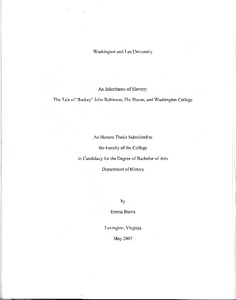| dc.rights.license | In Copyright | en_US |
| dc.creator | Burris, Emma Lynn | |
| dc.date.accessioned | 2023-04-21T19:30:36Z | |
| dc.date.available | 2023-04-21T19:30:36Z | |
| dc.date.created | 2007 | |
| dc.identifier | WLURG038_Burris_thesis_2007 | |
| dc.identifier.uri | https://dspace.wlu.edu/handle/11021/36197 | |
| dc.description.abstract | Much of the Washington College slaves' inner lives remain a mystery. The evidence does, of course, illuminate a great deal about the general course of their lives. John Robinson acquired and later bequeathed them to Washington College. In his 1825 will, he required that they be kept on his Hart's Bottom plantation for the span of fifty years following his decease. He wanted their happiness and family life protected, but he did not suggest they be given their freedom. With his death in 1826, Robinson's slaves passed into the hands of the Trustees, who betrayed the wishes of their benefactor. They sold most of the Robinson slaves into the South's developing Cotton Kingdom after a mere decade of ownership. The Washington College Trustees contravened one of the will's basic terms but respected Robinson's desire to keep the slave families intact. They kept spouses together and children with their parents. The ties of community and extended family, however, fell by the wayside. In late 1835 or early 1836, the Robinson slaves left their Lexington home for the cotton plantations of their new owner, Samuel Garland, a prominent resident of nearby Lynchburg, Virginia. Garland was an absentee master, relying on his brother Burr-to run the plantation and its daily operations. Part of the slave population disappeared into the Cotton Kingdom, while others stayed behind and were slowly sold away or cared for until their deaths. Along the way, the Robinson slaves experienced personal loss, joy, and new beginnings. Members of the original Robinson slave community were divided by death and distance from the ones they loved. They labored, they lived their lives the best they could, and they died. Throughout the years they spent in bondage, they also asserted themselves, challenged their masters' rules, and struggled to make lives for themselves both within and outside of the system of chattel bondage. Their stories, even filtered through white accounts, are as diverse as they are difficult to uncover. The slaves owned by Washington College were men and women known to the historical record through their first names, prices, and relationships with white men. A great deal, however, happens in life when the record keepers are not looking. [From Introduction] | en_US |
| dc.format.extent | 56 pages | en_US |
| dc.language.iso | en_US | en_US |
| dc.rights | This material is made available for use in research, teaching, and private study, pursuant to U.S. Copyright law. The user assumes full responsibility for any use of the materials, including but not limited to, infringement of copyright and publication rights of reproduced materials. Any materials used should be fully credited with the source. | en_US |
| dc.rights.uri | http://rightsstatements.org/vocab/InC/1.0/ | en_US |
| dc.subject.other | Washington and Lee University -- Honors in History | en_US |
| dc.title | An Inheritance of Slavery: The Tale of "Jockey" John Robinson, His Slaves, and Washington College | |
| dc.type | Text | en_US |
| dcterms.isPartOf | WLURG38 - Student Papers | |
| dc.rights.holder | Burris, Emma Lynn | |
| dc.subject.fast | Robinson, John -- 1754?-1826 | en_US |
| dc.subject.fast | Slavery | en_US |
| dc.subject.fast | Washington College (Lexington, Va.) | en_US |
| dc.subject.fast | Virginia -- Rockbridge County | en_US |
| local.department | History | en_US |
| local.scholarshiptype | Honors Thesis | en_US |
